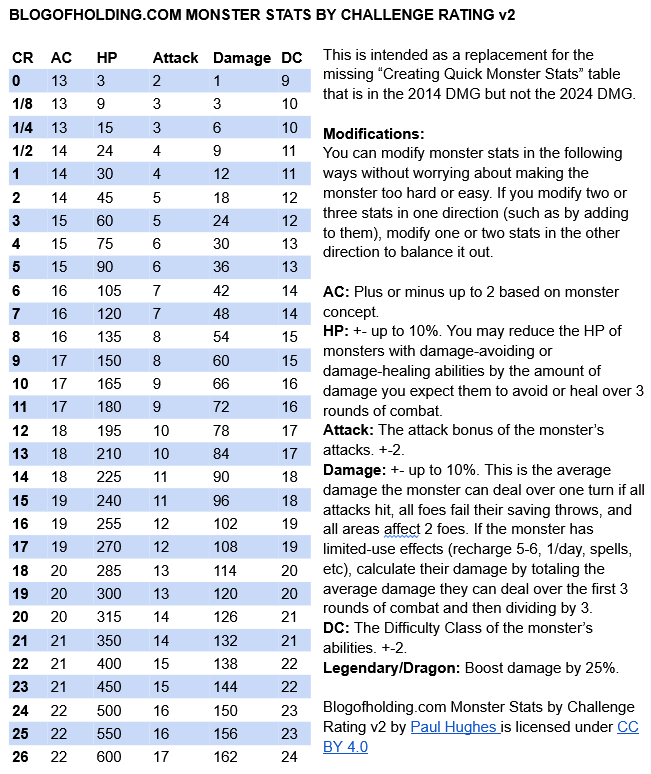OK, I am going through it now, and here are my thoughts as I go through.
Point #1
The business card approach is good for a general idea / quick build monster. But doesn't really give you full monster creation guidelines. It is better, but I don't consider this much better than reskinning.
Point #2
I have an issue with what Paul thinks is most important, if this is all he is considering. I will keep reading to see if there if more to it.
"To do this analysis, I plugged in each monster’s statistics from the 2024 Monster Manual into a spreadsheet. The most important statistics, in my opinion, are hit points and damage per round, but we should also consider AC, attack bonus, and effect DC, and we might as well also look at correlations between the various statistics."
Point #3
Yep, here is my issue. It is not reverse engineering how WotC creates monsters, but really just an analysis of the monsters and then saying you can do X, Y, & Z to create "similar" monsters.
"I also want to add a disclaimer: my analysis is just a cursory one, using a monster’s raw numbers. It doesn’t weigh in the balance a monster’s special exception-based features and condition-imposing effects – for instance, I don’t try to judge whether knocking someone prone is as valuable as gaining advantage. I specially flagged a few monsters with major offensive or defensive features – the medusa, which can remove a character from play; the rug of smothering, which can share damage; and so on – and left these monsters out of my accounting. For the vast bulk of monsters, I just don’t account for these details."
Point #4
As an example of my points above, see below. Paul notes the demilich is a statistical deviant, but doesn't / can't tell us why. I am hoping to figure out why in my own analysis (which I was going to start today, but I guess I will start tomorrow - anyone got a 2024 monster spreadsheet that want to share?!)
"Now let’s compare all that information to CR 18! As you can see, all five of those lines come together in one point, at 180 hit points. That’s because there’s only one CR 18 monster in the MM, the demilich, which has 180 hit points. That tells us that we can’t put a lot of faith in that number – it’s only a single data point. (And in fact, the demilich happens to have exceptionally low hit points and high damage output for its challenge rating.)"
Point #5
He notes that monster HP doesn't really go up until about CR 17. That is surprising as I thought it would start closer to CR 10 or 11
Point #6
DPR sees a jump almost immediately compared to 2014 monsters. Damage increases about +7.5 damage per CR instead of 5 per CR. With another bump at CR 20.
Point #7
Attack bonus is basically unchanged
Point #8
AC has gone up approximately 1 point across all CRs in 2024 monsters vs 2014 monsters.
Point #9
No change in DC between 2024 & 2014
Point #10:
This is where Paul fails IMO, see below. He doesn't, as far as I can tell, take into account any of the stats and traits that affect HP & AC and, to a lesser extent, attack bonus and DPR. So he concludes that monsters are unbalanced around their CR. He thought this in 2014 and makes the same, though improved, conclusion for 2024. I agree certain monsters may not be balanced only based on HP and DPR (to be reductive), but if you factor in (as the 2014 guideline tell us too) saving throws, traits, and features - they do balance out (at least better than he supposes).
"According to 2014 monster creation guidelines, when you raise one statistic (or add a special feature or the ability to impose a condition), you lower another statistic accordingly. Therefore, even leaving aside special features and conditions, you’d expect an inverse correlation between a high stat in one area and high stats elsewhere. For example, if a monster has very high hit points, you’d expect something to be lower – damage, AC, etc – to compensate for it. However, my 2014 analysis came to a startling conclusion: there was no statistically significant correlation between high damage, AC, or hit points and low statistics elsewhere. In other words, among the monsters with high hit points, you couldn’t expect lower damage or other stats to compensate. This was an unexpected finding – and seems like a flaw in the 2014 monster manual, with especially high or low scores leading to unbalanced monsters!"
Point #11
Paul notes that the discrepancy between monster types has mostly disappeared. That is good to see. Dragons, as Paul notes, were notoriously OP for their CR. They are know inline with all other monsters.
Final Words;
An interesting article and analysis. But it falls short, IMO, of providing true monster design guidelines. It gives no guidance on how the interesting an unique features monsters have might impact their CR. Knowing HP, AC, attack bonus, DPR is a good starting point but it is the special little traits that make monsters interesting. Paul provides no means to accommodate those in your design.

